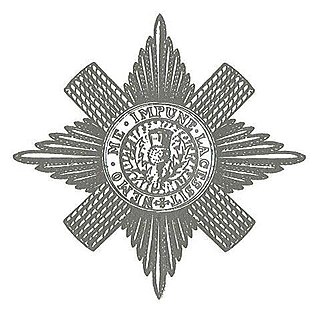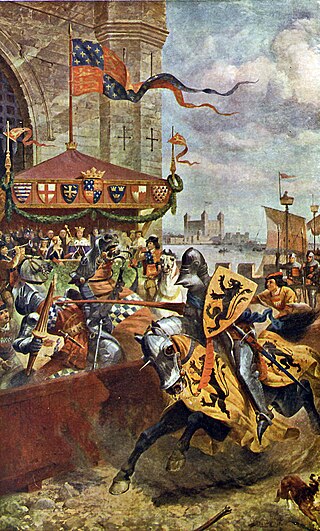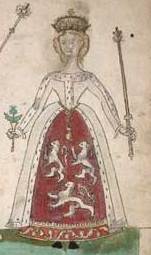Related Research Articles

Dunfermline Abbey is a Church of Scotland parish church in Dunfermline, Fife, Scotland. The church occupies the site of the ancient chancel and transepts of a large medieval Benedictine abbey, which was sacked in 1560 during the Scottish Reformation and permitted to fall into disrepair. Part of the old abbey church continued in use at that time and some parts of the abbey infrastructure still remain.

The Lord President of the Court of Session and Lord Justice General is the most senior judge in Scotland, the head of the judiciary, and the presiding judge of the College of Justice, the Court of Session, and the High Court of Justiciary. The Lord President holds the title of Lord Justice General of Scotland and the head of the High Court of Justiciary ex officio, as the two offices were combined in 1836. The Lord President has authority over any court established under Scots law, except for the Supreme Court of the United Kingdom and the Court of the Lord Lyon.

The Right Honourable the Lord Lyon King of Arms, the head of Lyon Court, is the most junior of the Great Officers of State in Scotland and is the Scottish official with responsibility for regulating heraldry in that country, issuing new grants of arms, and serving as the judge of the Court of the Lord Lyon, the oldest heraldic court in the world that is still in daily operation.

Earl of Crawford is one of the most ancient extant titles in Great Britain, having been created in the Peerage of Scotland in 1398 for Sir David Lindsay. It is the premier earldom recorded on the Union Roll.

Earl of Balcarres is a title in the Peerage of Scotland, created in 1651 for Alexander Lindsay, 2nd Lord Balcarres. Since 1848, the title has been held jointly with the Earldom of Crawford, and the holder is also the hereditary clan chief of Clan Lindsay.

Earl of Lindsay is a title in the Peerage of Scotland. It was created in 1633 for John Lindsay, 10th Lord Lindsay, who later inherited the ancient Earldom of Crawford. The two earldoms remained united until the death of the 22nd Earl of Crawford, also sixth Earl of Lindsay, in 1808. Then the earldom of Lindsay passed to David Lindsay, while the earldom of Crawford became dormant because no-one could prove a claim to the title until 1848. Both David, 7th Earl of Lindsay, and his successor Patrick, 8th Earl of Lindsay, died without sons, and the disputed claim over the earldom was resolved by the House of Lords in 1878 in favour of Sir John Trotter Bethune, 2nd Baronet.

The Lords of the Congregation, originally styling themselves the Faithful, were a group of Protestant Scottish nobles who in the mid-16th century favoured a reformation of the Catholic church according to Protestant principles and a Scottish-English alliance.

Robert Alexander Lindsay, 29th Earl of Crawford, 12th Earl of Balcarres, Baron Balniel,, known by courtesy as Lord Balniel between 1940 and 1975, was a Scottish hereditary peer and Conservative politician who was a member of Parliament from 1955 to 1974. Lord Crawford and Balcarres was chief of Clan Lindsay and also acted, from 1975 to 2019, as Premier Earl of Scotland.

David Lindsay, 1st Earl of Crawford was a Scottish peer who was created Earl of Crawford in 1398.
Gille Críst, Earl of Angus ruled until 1206 Mormaer of Angus. He was a son of Gille Brigte of Angus and younger brother of Adam of Angus.
The Battle of Sauchieburn was fought on 11 June 1488, at the side of Sauchie Burn, a stream about two miles (3 km) south of Stirling, Scotland. The battle was fought between the followers of King James III of Scotland and a large group of rebellious Scottish nobles including the future Alexander Home, 2nd Lord Home, who were nominally led by the king's 15-year-old son, James, Duke of Rothesay. James III was killed in the battle, and his son succeeded him as James IV.

Euphemia de Ross (1329–1386), a member of Clan Ross, was Queen of Scots as the second wife of Robert II of Scotland.

Clan Carnegie is a Lowland Scottish clan.

Clan Lindsay is a Scottish clan of the Scottish Lowlands.
Holders of the office of Lord Chamberlain of Scotland are known from about 1124. It was ranked by King Malcolm as the third great Officer of State, called Camerarius Domini Regis, and had a salary of £200 per annum allotted to him. He anciently collected the revenues of the Crown, at least before Scotland had a Treasurer, of which office there is no vestige until the restoration of King James I when he disbursed the money necessary for the maintenance of the King's Household.
Alexander Leslie, Earl of Ross was a Scottish nobleman. Born between 1367 and 1382, he was the son of Walter Leslie, Lord of Ross and Euphemia I, Countess of Ross. In around 1394, or not later than 1398, he became Earl of Ross and sometime before 1398 he married Isabel Stewart, daughter of Robert Stewart, Earl of Fife who became Robert Stewart, Duke of Albany. They had one child, Euphemia. He died at Dingwall, Scotland on 8 May 1402.
Elizabeth Stewart, Princess of Scotland was the daughter of Robert II of Scotland and Euphemia de Ross. She was born between 1356 and 1370, well after her parents' marriage on 2 May 1355. Her brothers were David Stewart, Earl of Strathearn and Walter Stewart, Earl of Atholl, and her half-brother was Robert III of Scotland.
James Lindsay, 7th Lord Lindsay PC, Scottish landowner who was a gentleman of King James's bedchamber.

Sir James (de) Lindsay, 9th Lord of Crawford, Knight Banneret, Lord of Crawford, Kirkmichael, Wigton, Symontoun, and of many other baronies, claiming also to be Lord of Buchan, was a Scottish feudal lord.
John Lindsay, 8th Lord Lindsay PC, was a Scottish landowner.
References
- Douglas, Robert. The Peerage of Scotland, containing an Historical and Genealogical Account of the Nobility of that Kingdom from their origin to the present generation; collected from the public records and ancient chartularies of this nation, the charters and other writings, and the works of our best historians. 1764.